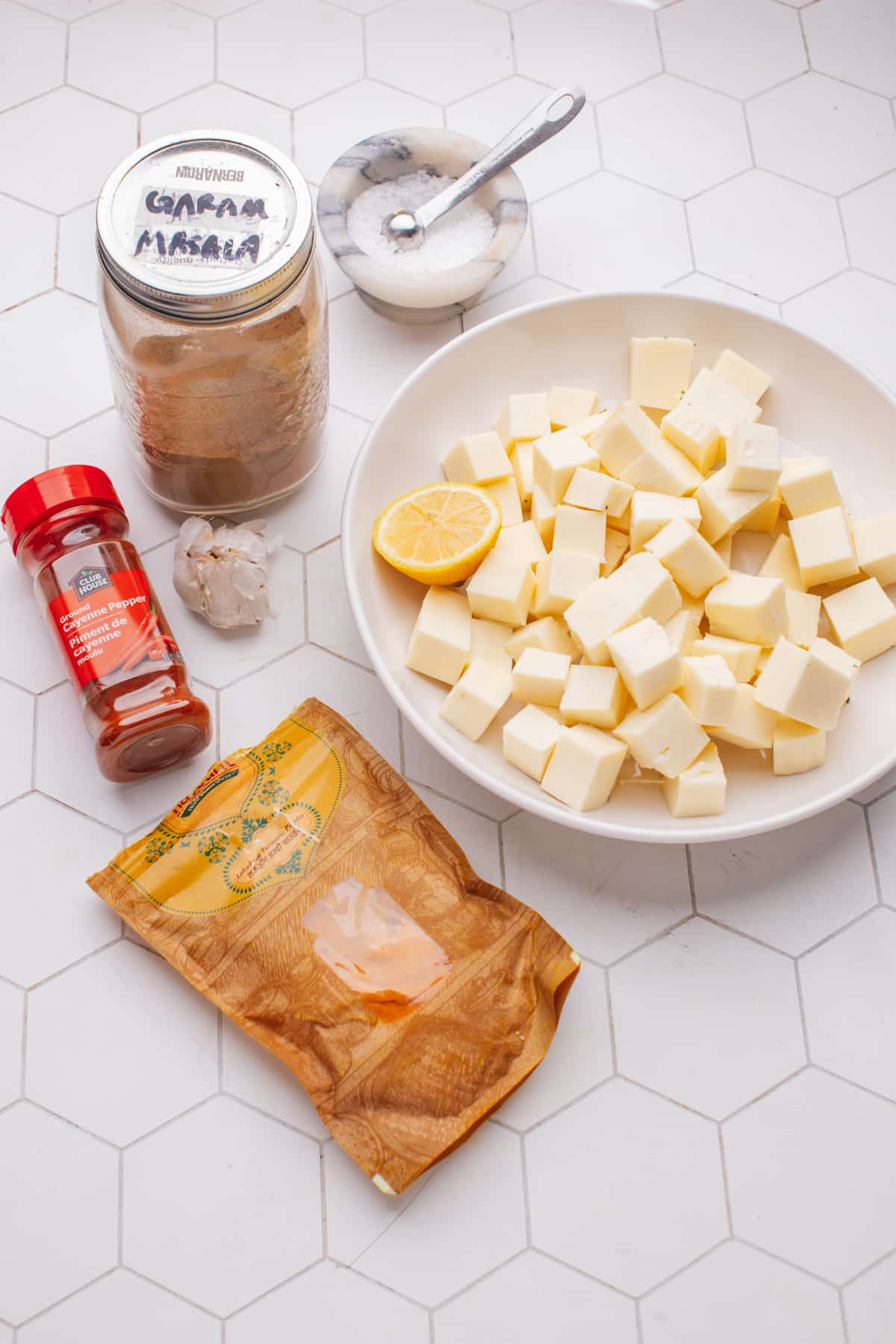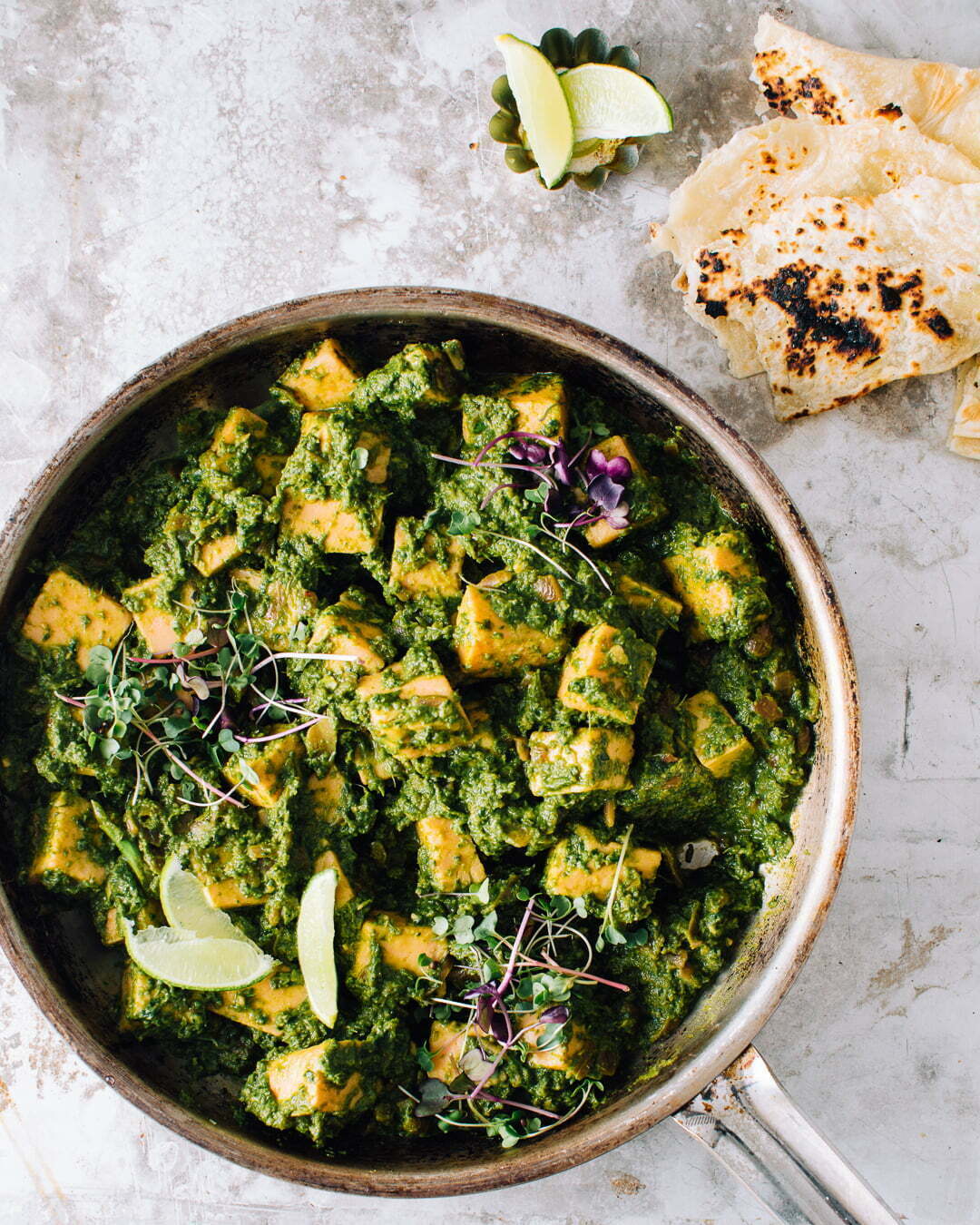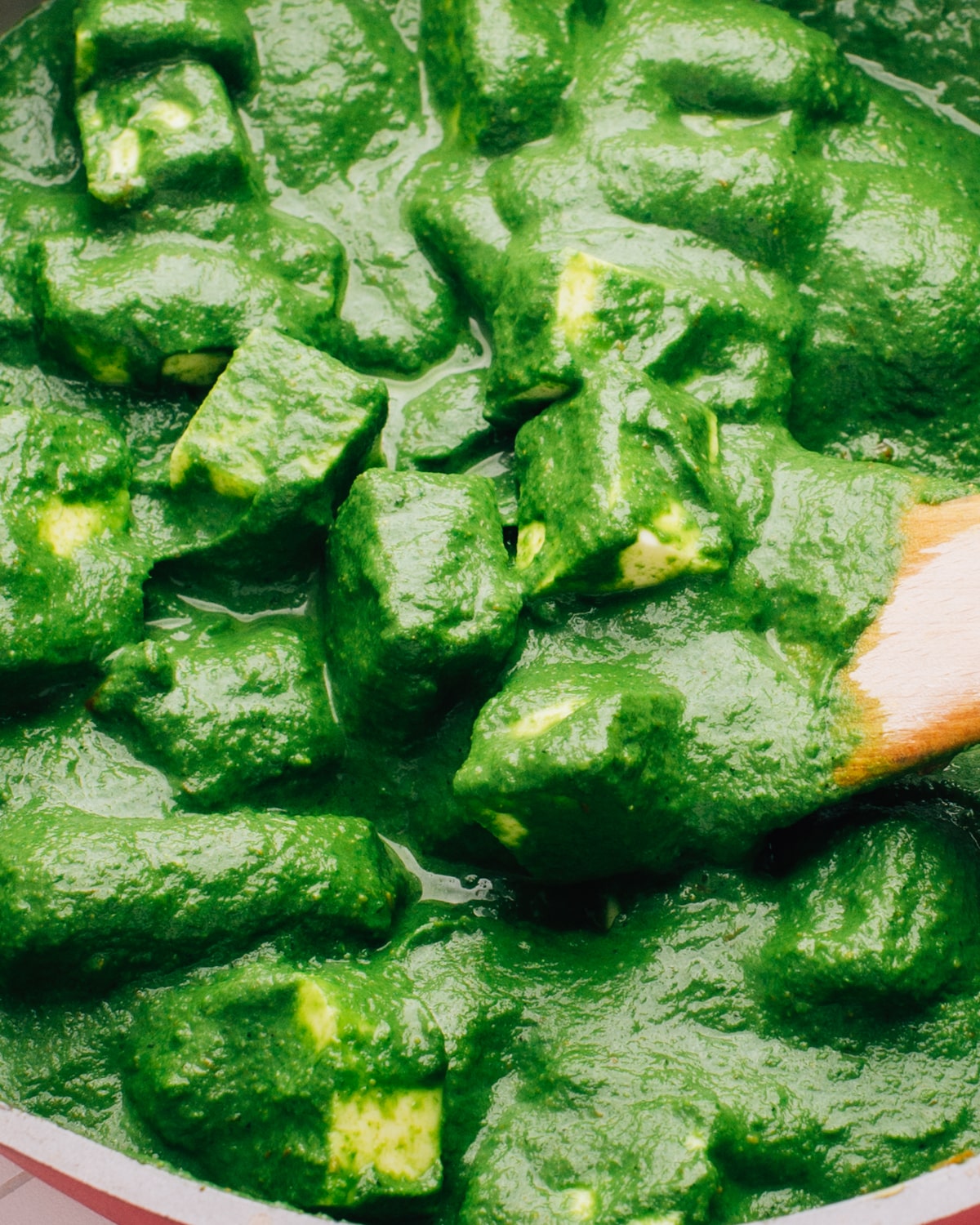Palak Paneer vs Saag Paneer (Key Differences to Know!)
Feb 01, 2024, Updated Mar 10, 2024
There are key differences between Palak Paneer vs Saag Paneer from ingredients to nutrition. Find out what’s important to know about both!
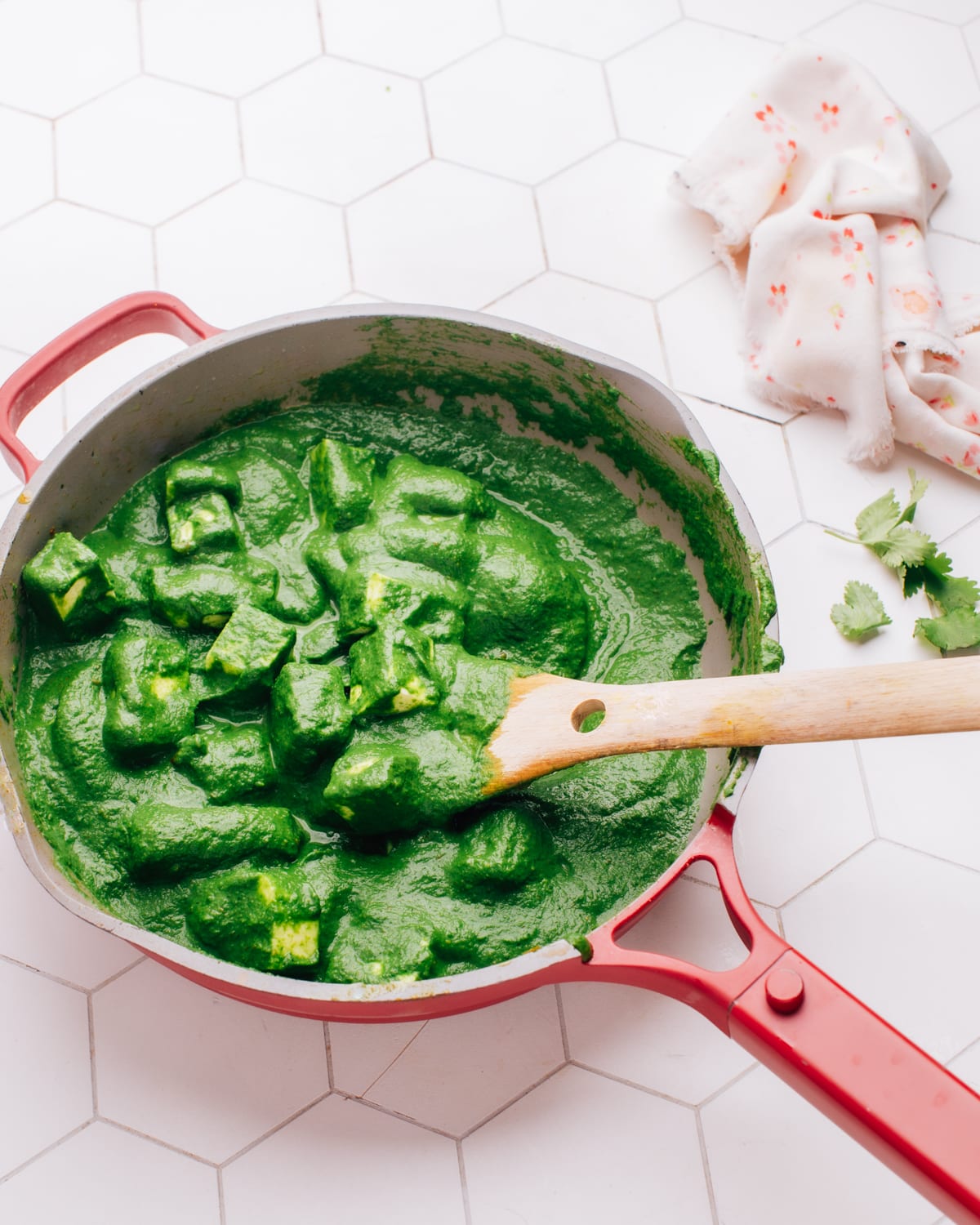
Saag Paneer vs. Palak Paneer: At a Glance
Saag Paneer and Palak Paneer are both popular dishes in Indian cuisine (and in my half-Indian family).
Here’s a fast rundown on what sets Saag Paneer and Palak Paneer apart:
- Greens Used: Saag Paneer uses a mix of greens like spinach, mustard greens, and fenugreek leaves, offering a complex flavor. Palak Paneer sticks to spinach for a simpler, more focused taste.
- Texture: Saag Paneer has a more varied, sometimes chunkier texture due to the mix of greens. Palak Paneer is known for its smooth, creamy consistency. Spinach is blended until smooth using a regular or immersion blender.
- Flavor Profile: The variety in Saag Paneer brings a richer, more layered flavor, while Palak Paneer offers a mild, spinach-focused taste that’s often enriched with cream (though some versions of Saag Paneer might also include extra dairy to soften the flavors).
- Dairy Content: Palak Paneer typically includes cream or yogurt, making it creamier. Traditional Saag Paneer may not use additional dairy, but modern recipes often add it for richness.
Read on for the complete scoop with recipes and nutrition info!
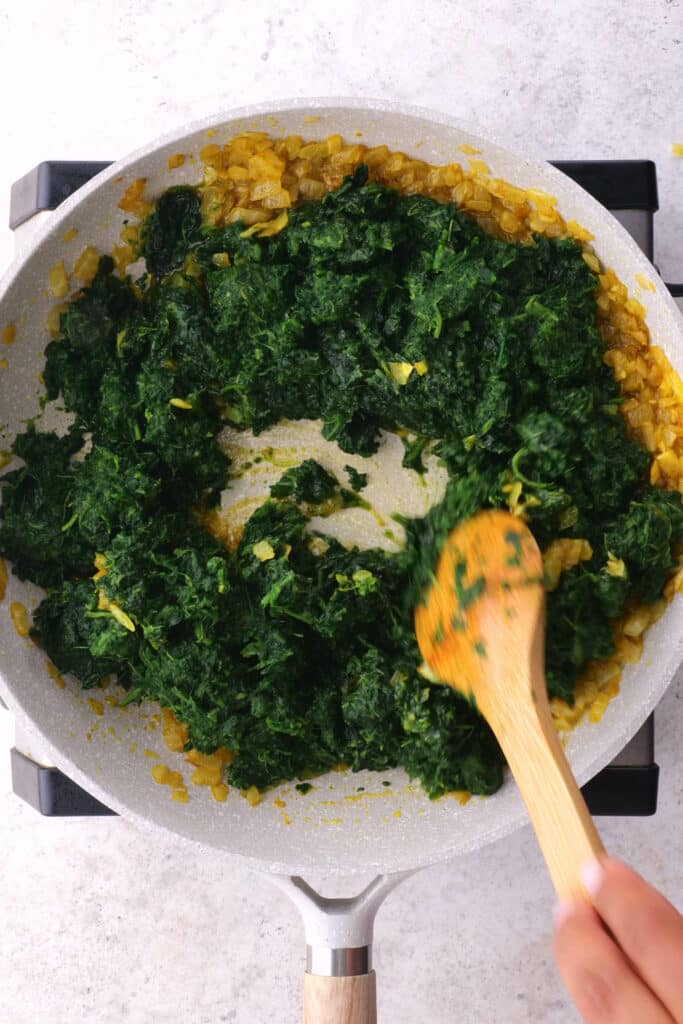
Saag vs Palak Paneer: Ingredients
When it comes to distinguishing Saag Paneer from Palak Paneer, the difference in ingredients is minor. In essence, the main difference lies in the variety of greens used and the possible addition of cream or yogurt.
Saag Paneer Ingredients:
Saag Paneer is a dish made with a mix of greens. “Saag” refers to greens in general, which can include mustard greens, spinach, fenugreek leaves, and collard greens, among others.
Here’s a quick rundown of what you’ll need for Saag Paneer:
- Leafy Greens: Pick any mix you like—spinach, kale, collard greens, mustard greens, or rapini. They’re the star of the show.
- Ghee or Butter: For cooking and adding a rich flavor to the base.
- Onion: Chopped, it adds sweetness and depth.
- Fresh Ginger and Garlic Cloves: Minced or grated, these aromatics bring heat and punch.
- Turmeric: A touch for color and its earthy notes.
- Cumin: Adds a warm, aromatic spice.
- Fenugreek Powder or Curry Powder: For that distinct savory flavor unique to Saag.
- Heavy Cream or Yogurt: Makes the dish creamy and balances the greens’ bitterness.
- Lemon Juice: A splash to brighten everything up.
- Salt: To taste, bringing all the flavors together.
- Paneer or Drained Ricotta: Cubed, for a soft, chewy texture in every bite.
Here’s my favorite Saag Paneer recipe.
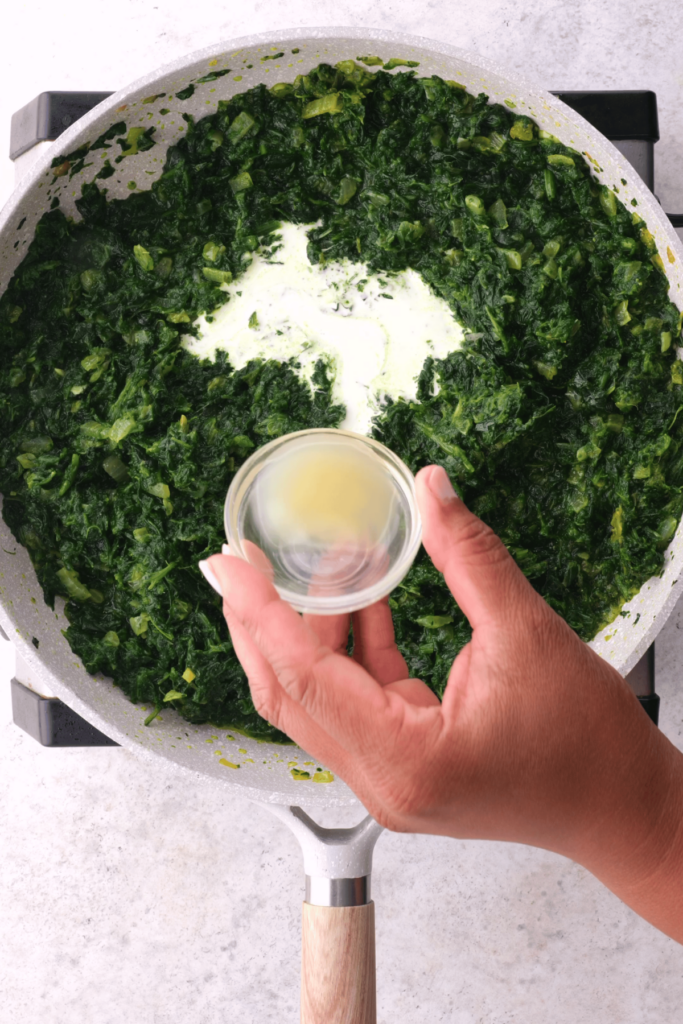
Palak Paneer Ingredients
Palak Paneer, on the other hand, focuses solely on spinach (“Palak” in Hindi). This dish is simpler in terms of its green component, using only spinach to create a vibrant, somewhat smoother sauce. Here’s what you’ll need to whip up Palak Paneer:
- Spinach Leaves: The green foundation of the dish, offering a smooth and vibrant base. You can use frozen or fresh spinach leaves.
- Ghee or Butter: Used to sauté and introduce richness.
- Onion: Provides a layer of sweet flavor.
- Ginger and Garlic: Key for adding a spicy and aromatic kick.
- Turmeric: Brings color and subtle earthiness.
- Cumin seeds: Contributes its warm, aromatic essence.
- Fenugreek Powder (Kasuri Methi): Offers complex, savory notes.
- Lemon Juice: Adds a fresh, tangy lift to the dish.
- Salt: Essential for seasoning and enhancing all the flavors.
- Paneer or Drained Ricotta: Adds creamy, chewy chunks to contrast the smooth spinach.
Here’s my favorite Palak Paneer recipe.
Note on Ingredients:
All of these ingredients can be found at most North American grocery stores (and definitely indian grocery stores).
For a little more heat, green chilies, cayenne pepper, red chili powder, and/or hot paprika may be added.
What About Cream or Yogurt?
In traditional preparations of Saag Paneer, cream is not always a key ingredient, unlike in Palak Paneer, where cream or yogurt is often added to achieve a rich, creamy texture.
Saag Paneer focuses more on the blend of greens and spices, with the primary goal being to highlight the complex flavors of the various greens used in the dish. However, modern adaptations of Saag Paneer recipes may include cream, yogurt, or even coconut milk to add richness and soften the flavors, making the dish more appealing to a wider audience.
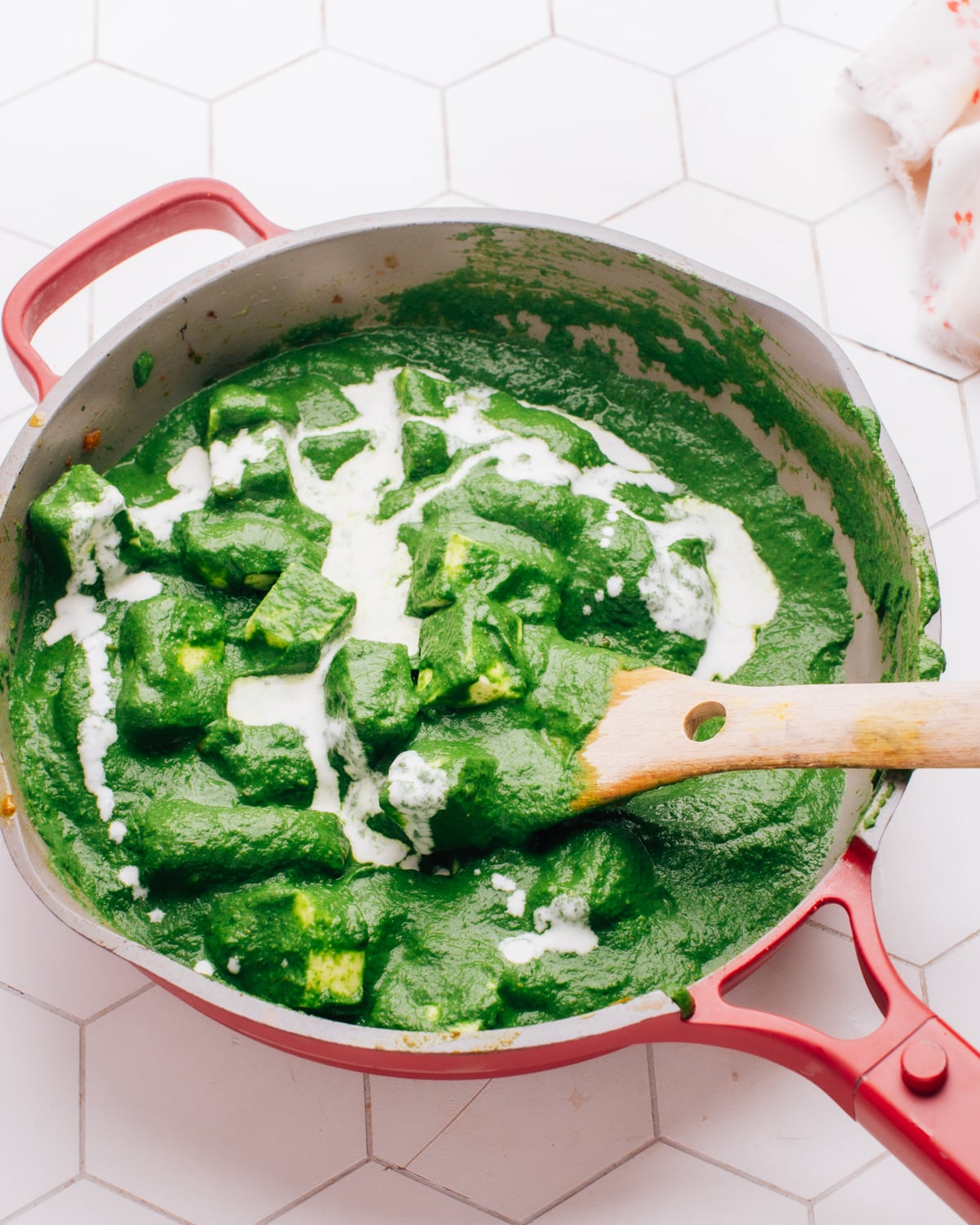
Saag Paneer vs. Palak Paneer: Texture and Flavor
The distinctions between Saag Paneer and Palak Paneer aren’t just about ingredients or nutrition; they extend significantly into the realms of texture and flavor, offering unique sensory experiences.
Texture
- Saag Paneer traditionally has a more rustic and coarse texture. This is because it incorporates a mix of greens, which can vary in texture themselves. When these greens are cooked down and then pureed or finely chopped, they contribute to a thicker, more varied consistency in the dish. The inclusion of different types of greens can also affect the sauce’s consistency, making it less uniform than Palak Paneer.
- Palak Paneer, on the other hand, is known for its smooth and creamy texture. The spinach is usually blanched and pureed to a fine consistency before being combined with the rest of the ingredients. This results in a velvety sauce that beautifully coats the paneer cubes. The addition of cream or yogurt enhances this smoothness, giving Palak Paneer a luxurious mouthfeel.
Flavor
- The flavor profile of Saag Paneer is complex and layered. The variety of leafy greens used brings a depth of flavor that can range from slightly bitter or peppery (from mustard greens) to earthy (from spinach).
- Palak Paneer offers a more focused flavor, with the sweetness and mildness of spinach shining through. The creamy sauce, enriched with spices, complements the gentle, vegetal taste of spinach, creating a harmonious and somewhat milder dish compared to Saag Paneer. The simplicity of the spinach allows the flavors of the spices and cream to be more pronounced, offering a straightforward yet rich taste profile.
I have a big spot in my heart (and stomach) for both!

Saag Paneer vs. Palak Paneer: Regional Variations
The differences between Saag Paneer and Palak Paneer extend into how these dishes are prepared and enjoyed across various regions of India, reflecting local tastes, traditions, and available ingredients.
Saag Paneer
- In the northern regions of India, particularly in Punjab, Saag Paneer is a staple during the colder months. The traditional Punjabi version uses mustard greens (sarson) as the primary green, often mixed with spinach and sometimes other greens like bathua (chenopodium). This mix gives the dish a distinct, robust flavor characteristic of Punjabi cuisine.
- In other northern areas, variations may include different proportions of greens or the addition of local greens, adjusting the flavor profile to suit regional tastes.
Palak Paneer
- Palak Paneer, while popular across India, has its own regional twists. In North India, it’s often prepared with a rich base of cream and tomatoes, making it a decadent dish served in restaurants and homes alike.
- In the South, cooks might add curry leaves or mustard seeds to the tempering oil, introducing a hint of South Indian flavor to the dish. This slight adjustment adds a new dimension to the familiar taste of Palak Paneer.
These Indian Curries Beyond Borders
- Beyond India, both dishes have been adapted to suit local ingredients and dietary preferences. For instance, in Western countries, kale or collard greens might find their way into Saag Paneer, while vegan versions of Palak Paneer might use coconut milk instead of cream.
- In regions where paneer is not readily available, substitutes like extra firm tofu or halloumi cheese are used, offering a different texture and nutritional profile while keeping the spirit of the dish alive.
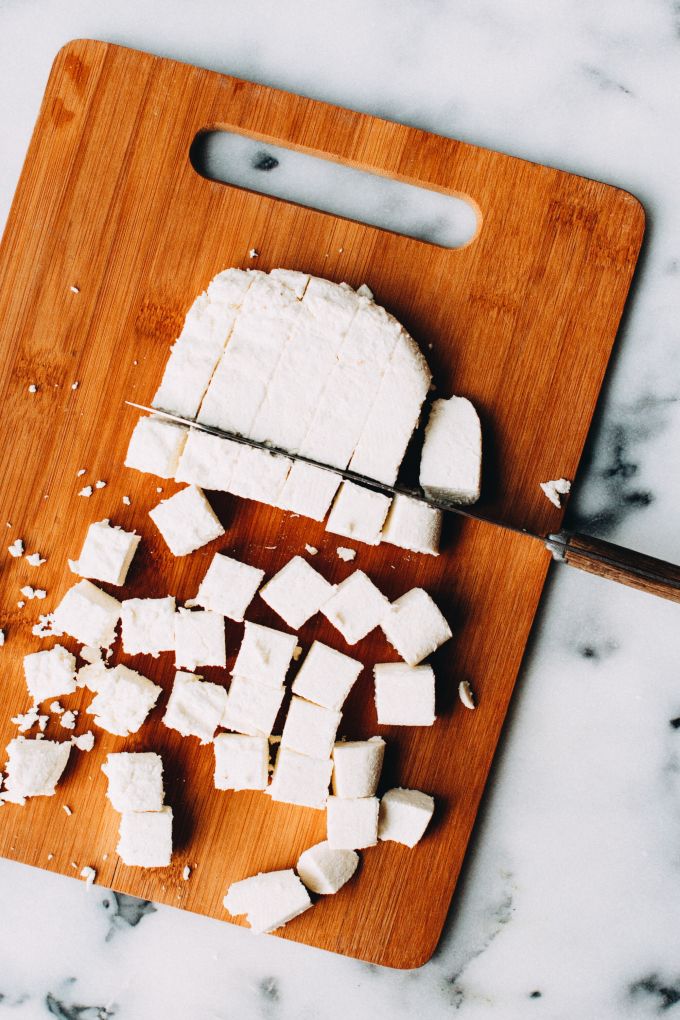
Psst. Here is my tried-and-true homemade paneer recipe!
Palak Paneer vs. Saag Paneer: Which one is More Popular?
In North American restaurants, Palak Paneer tends to be more common. It’s a bit of a favorite because of its creamy texture and mild, spinach-based flavor that appeals to a wide audience. Plus, its smooth, vibrant sauce looks great on a plate, making it a popular choice for those new to Indian cuisine or anyone looking for a comforting, familiar taste.
In India, both Saag Paneer and Palak Paneer are popular, but their prevalence can depend on the region. Saag Paneer is more common in the northern regions of India, especially in Punjab, where it’s a traditional dish made with a mix of local greens, including mustard greens.
This version is deeply rooted in local culinary traditions and is especially enjoyed during the cooler months. Palak Paneer, while also enjoyed across India, doesn’t have the same regional specificity and can be found widely in restaurants and homes alike, making it a universally loved dish.
So, in North America, you’re more likely to come across Palak Paneer on menus, while in India, the popularity of Saag Paneer and Palak Paneer varies by region, with both having their own loyal followings.

Saag Paneer vs. Palak Paneer: Quick Nutritional Overview
Both Saag Paneer and Palak Paneer pack a nutritious punch, loaded with protein, vitamins, and minerals. The main differences come down to the greens used and dairy additions.
- Calories and Fat: Palak Paneer often has more calories and fat due to cream or yogurt, making it richer. Saag Paneer might be leaner, especially if it skips the cream.
- Protein: Paneer brings plenty of protein to both dishes, great for vegetarians.
- Vitamins and Minerals: Saag Paneer could edge out with more varied nutrients from its mix of greens. Palak Paneer shines with iron and vitamins from spinach.
- Fiber: Saag Paneer could have slightly more fiber from its diverse greens, but both offer this essential nutrient.
Overall, Saag Paneer might offer more varied nutrients, while Palak Paneer could be richer in calories and fat. Both, however, are healthy options when enjoyed in moderation.

Serving Saag Paneer and Palak Paneer
Both Saag Paneer and Palak Paneer are best served warm, topped with cilantro (fresh coriander) and can be enjoyed with a variety of sides. Here’s how to turn these dishes into a complete meal:
- With Naan: The soft, pillowy texture of butter naan is perfect for scooping up the rich sauces of both dishes.
- Paratha: This flaky, layered paratha recipe is so delicious. Worth the extra effort! (See: Paratha vs Naan)
- Roti: My soft roti is great for wrapping or dipping. (See: Roti vs Naan)
- Rice: Here’s my Indian mother-in-law’s easy basmati rice recipe.
- Jeera Rice: For something with a bit more flavor, jeera (cumin) rice adds a fragrant and slightly nutty taste that pairs wonderfully with both dishes.
I love to make a big batch and pack leftovers into airtight containers for easy meal prep for the week packed with protein.
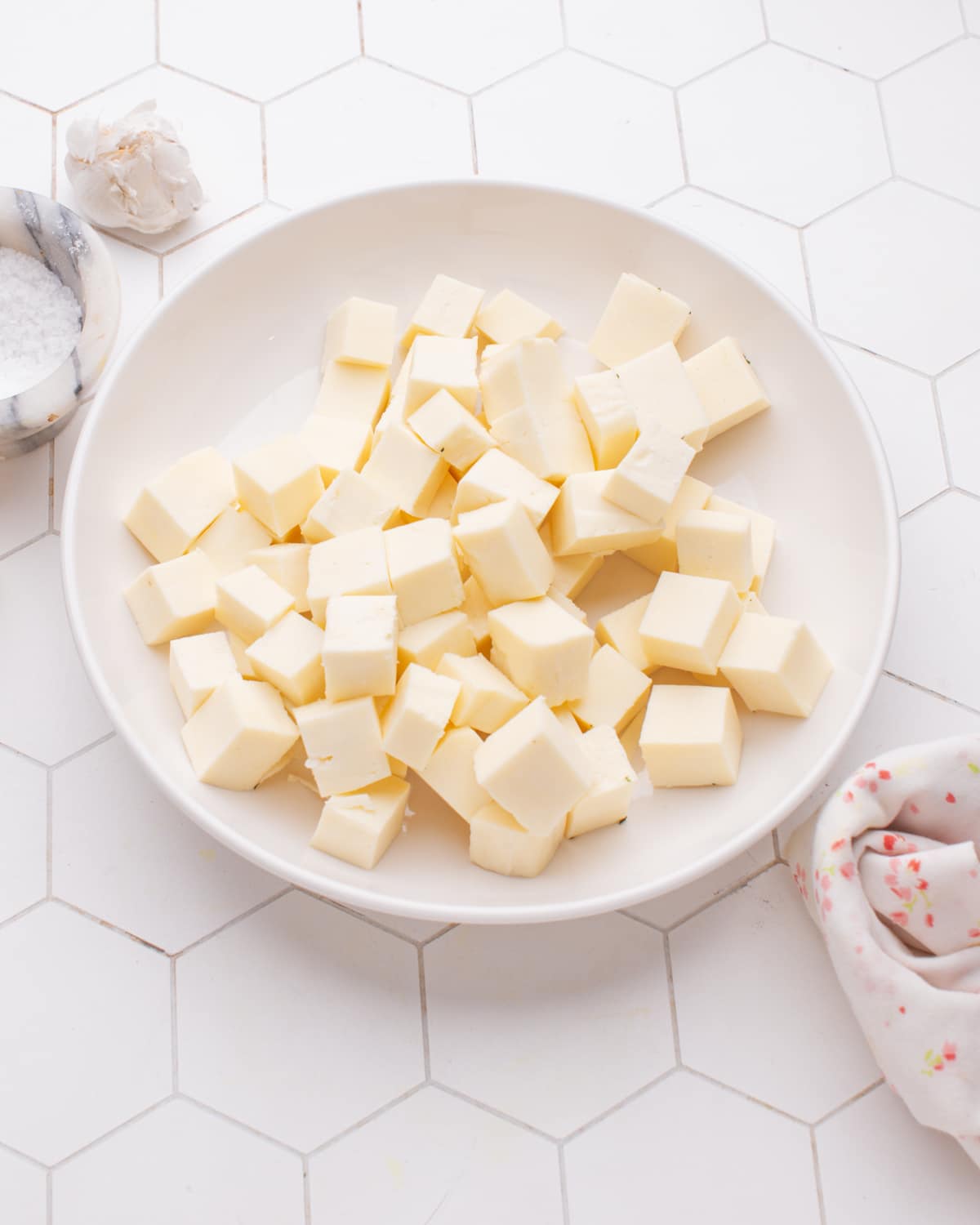
Next Paneer Reading:
- How to Make Homemade Paneer (Indian cottage cheese)
- How to Marinate Paneer
- 52+ of the Best Paneer Recipes on the Internet
- Saag Paneer
- Palak Paneer
- Malai Kofta (with paneer and potato balls in creamy sauce
- Butter Paneer (my favorite paneer recipe!)


